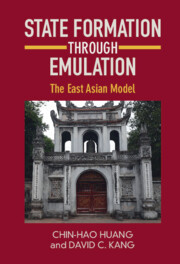Book contents
- State Formation through Emulation
- State Formation through Emulation
- Copyright page
- Epigraph
- Contents
- Preface
- 1 Introduction
- 2 Theories of State Formation and Diffusion
- 3 Phase I and Onwards
- 4 The Absence of Bellicist Pressures in State Formation, 400–800 CE
- 5 Phase II
- 6 Korea and Japan over the Centuries
- 7 Vietnam Emerges
- 8 Epistemic Communities and Regional Connections
- 9 Who Doesn’t Emulate?
- 10 Conclusion
- Appendix Major Events in Sinicization, 300–1100 CE
- Bibliography
- Index
2 - Theories of State Formation and Diffusion
Published online by Cambridge University Press: 21 July 2022
- State Formation through Emulation
- State Formation through Emulation
- Copyright page
- Epigraph
- Contents
- Preface
- 1 Introduction
- 2 Theories of State Formation and Diffusion
- 3 Phase I and Onwards
- 4 The Absence of Bellicist Pressures in State Formation, 400–800 CE
- 5 Phase II
- 6 Korea and Japan over the Centuries
- 7 Vietnam Emerges
- 8 Epistemic Communities and Regional Connections
- 9 Who Doesn’t Emulate?
- 10 Conclusion
- Appendix Major Events in Sinicization, 300–1100 CE
- Bibliography
- Index
Summary
A state is most centrally composed of an administrative bureaucracy. An enormous literature extrapolates the European experience as universal and, with various modifications, asserts that the demands of war drive states to create institutions that can extract resources from society. There is remarkably little scholarship on state formation in East Asia that engages the social science literature. Most state formation occurred centuries after the initial emergence of centralized Chinese rule in the 2nd century BC, but scant scholarship explores it. Furthermore, much of the bellicist literature does not address the question of diffusion, implying diffusion through natural selection or market forces: those units that adapted best survived, those that didn’t were “winnowed.” In contrast to Europe, in East Asia there was clearly diffusion from core to periphery. Emulation, learning, and competition are all potentially present at the same time. The bellicist theory is possibly limited in that it selectively focuses its attention on a single mechanism of diffusion and institutional isomorphism at the expense of non-coercive mechanisms such as emulation.
- Type
- Chapter
- Information
- State Formation through EmulationThe East Asian Model, pp. 11 - 30Publisher: Cambridge University PressPrint publication year: 2022

